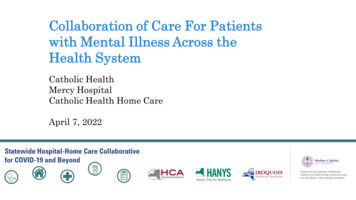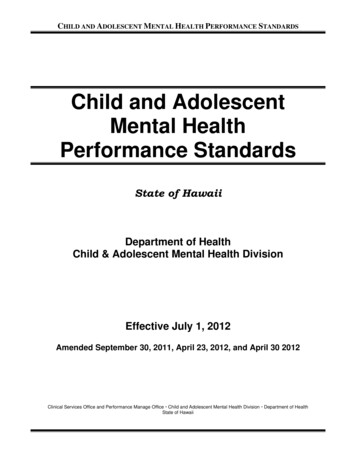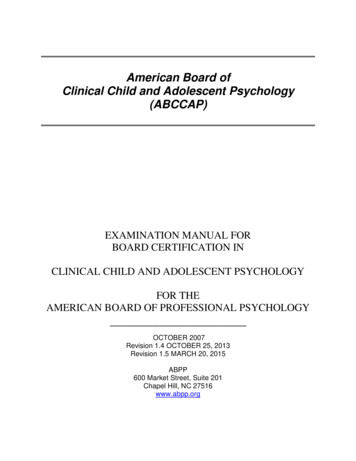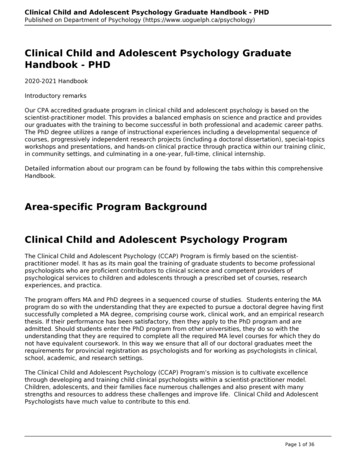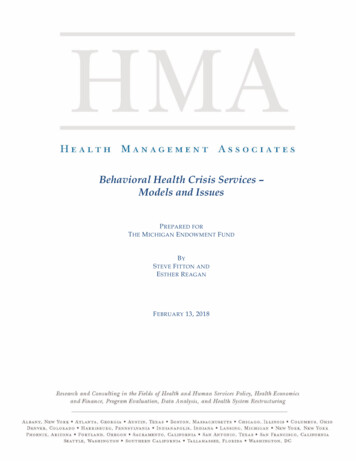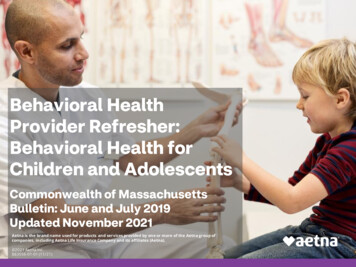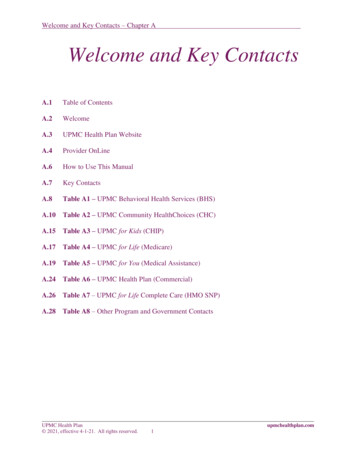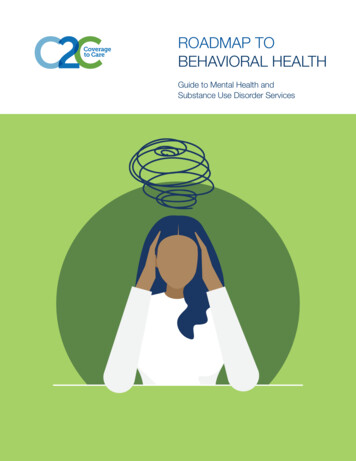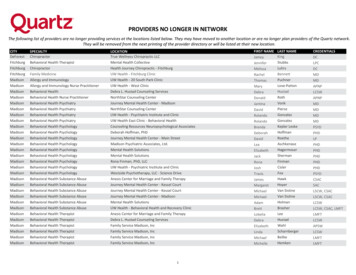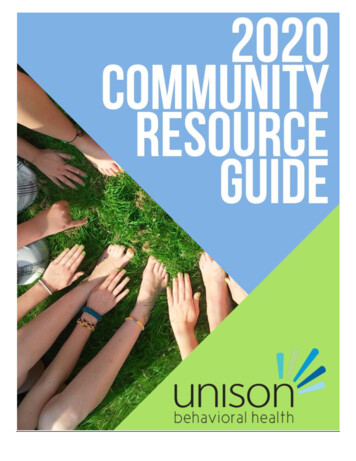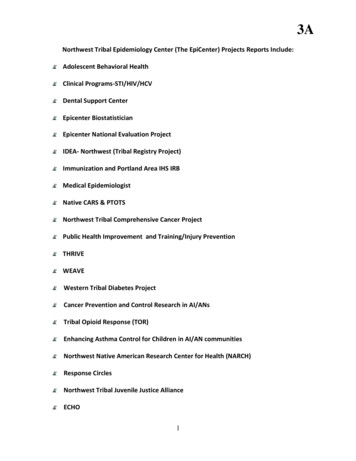
Transcription
3ANorthwest Tribal Epidemiology Center (The EpiCenter) Projects Reports Include:Adolescent Behavioral HealthClinical Programs-STI/HIV/HCVDental Support CenterEpicenter BiostatisticianEpicenter National Evaluation ProjectIDEA- Northwest (Tribal Registry Project)Immunization and Portland Area IHS IRBMedical EpidemiologistNative CARS & PTOTSNorthwest Tribal Comprehensive Cancer ProjectPublic Health Improvement and Training/Injury PreventionTHRIVEWEAVEWestern Tribal Diabetes ProjectCancer Prevention and Control Research in AI/ANsTribal Opioid Response (TOR)Enhancing Asthma Control for Children in AI/AN communitiesNorthwest Native American Research Center for Health (NARCH)Response CirclesNorthwest Tribal Juvenile Justice AllianceECHO1
3AAdolescent Behavioral HealthStephanie Craig Rushing, PhD, MPH, Principal Investigator Jessica Leston, MPH, PhD(c) Project DirectorColbie Caughlan, MPH, THRIVE Project Director David Stephens, RN, ECHO DirectorDanica Brown, MSW, PhD, Behavioral Health Manager Michelle Singer, HNY ManagerCelena McCray, THRIVE Project Coordinator Tommy Ghost Dog, WRN Project CoordinatorPaige Smith, Youth Engagement Coordinator DVPI CoordinatorCorey Begay, Multimedia Specialist Eric Vinson, ECHO Specialist Roger Peterson, SMS Communication SpecialistContractors: Amanda Gaston, MAT, Native IYG Nicole Trevino, Native STAND & We R Native Teacher’s Guide Jackie Johnson, TAM Research AssistantQuarterly Report: October-December 2019Technical Assistance and TrainingTribal Site Visits Confederated Tribes of Umatilla Indian Reservation.October Technical Assistance Requests 3 NW Tribal TA Requests Chemawa, Suquamish, Tulalip 5 Harlan, ORAETC, Yalda, Jeff, PREP EvalNovember Technical Assistance Requests 2 NW Tribal TA Requests Nimiipuu NARA 7 Tesuque Pueblo Johns Hopkins NIHB WA DOH Montana State University Portland PublicSchools IHSDecember Technical Assistance Requests 2 NW Tribal TA Requests Colville Nez Perce 2 Johns Hopkins NIHBWe R NativeDuring the quarter, our staff participated in four partner meetings, including: Zoom: TAM study check-in with mHealth, October 9, 2019. Zoom: TAM study check-in with mHealth, Nov 20, 2019. Zoom: TAM study check-in with Jackie, Nov 22, 2019. Zoom: TAM study check-in with mHealth, Dec 11, 2019.Gen I / Bootcamps N/AHealthy Native YouthDuring the quarter, Healthy Native Youth staff participated in nine planning calls with study partners, andthe following trainings/events: Booth: Spirit of Giving Conference, Portland, OR. Nov 15, 2019. Meeting: Strategic Planning Day, Portland, OR. Nov 13, 2019. Participant: We R Native and HNY, NB7 Advisory Meeting. October 16-17, 2019. Albuquerque, NM.Approximately 30 participants in attendance.2
3A Presentation: Native STAND, We R Native, HNY and BRAVE Mental Health Study, NIEA Conference.October 9-11, 2019. Approximately 75 participants in attendance.Presentation: We R Native and Healthy Native Youth, NPAIHB Quarterly Board Meeting,Confederated Tribes of Umatilla Indian Reservation, Pendleton, OR, October 23, 2019.Approximately 30 participants in attendance.Zoom: HNY CoP (Building Community Support), Nov 13, 2019. Approximately 35 participants inattendance.Zoom: HNY CoP (Intro to Evaluation), October 9, 2019. Approximately 35 participants in attendance.Zoom: HNY CoP (The Talk), Dec 11, 2019. Approximately 35 participants in attendance.ANA – I-LEADDuring the quarter, staff participated in three grantee call, six SMS text mentoring chats with 850 STEMand “healer” participants,” and the following I-LEAD meetings and activities: Committee: Youth Committee, NPAIHB Quarterly Board Meeting, Confederated Tribes of UmatillaIndian Reservation, Pendleton, OR, October 22, 2019. Zoom: Youth Delegate Monthly Check-in, Nov 3, 2019 The 2nd cohort of Youth Delegates has been selected. http://www.npaihb.org/youthdelegate/?fbclid IwAR1MFNzWdo5bxocP9kiU63fhUeE XiQ34TzU6STHX6alVkXffjfFdQn8PTg#FAQHealth Promotion and Disease PreventionWebsite: The Healthy Native Youth website launched on August 15, 2016: www.healthynativeyouth.orgLast month, the Healthy Native Youth website received: Page views 107Average session duration 1:55Website:The We R Native website launched on September 28, 2012: www.weRnative.orgIn July, the Monthly reach across the We R Native Channel: 217,579 (7,018/day)In August, the Monthly reach across the We R Native Channel: 161,773 (5,218/day)In December, the We R Native website received: Page views 25,559Average visit duration 6:593
3A Top 10 Content Topics /1p hyONt3fRun AdSFPySDlTZI0tYsEvq/page/CO6gDecember Social Reach Twitter Followers 6,664 (16,200 Impressions) YouTube: The project currently has 724 uploaded videos and has had 529,130 videoviews. (19,997 views last month) Facebook: By the end of the month, the page had 50,515 followers. Instagram: By the end of the month, the page had 9,926 followers. (19,284 Impressions)December Text Message Service: Northwest Portland Area Indian Health Board has 10,088 active subscribers.We R Native has 5,700 active subscribers.The Text 4 Sex Ed service currently has 465 active subscribers, 769 total profiles.STEM has 488 subscribers.We R Healers has 352 subscribers.Youth Spirit has 34 subscribers.We R Dine has 226 subscribers.I Know Mine has 604 subscribers.Native Fitness has 704 subscribers.Hepatitis C Patient and ECHO project has 416 subscribers.Healthy Native Youth has 452 subscribers.Research and SurveillanceTechnology and Adolescent Mental Health (TAM): The NPAIHB is partnering with the Social MediaAdolescent Health Research Team and the mHealth Impact Lab to evaluate We R Native’s mental healthmessaging impact and efficacy. The project is recruiting youth for an efficacy study.Enhancing Perspectives in Clinics and Communities ProgramsJessica Leston, MPH, Clinical Programs Director – TsimshianDavid Stephens, RN ECHO Clinic DirectorEric Vinson, BS, ECHO Clinic Manager – CherokeeMegan Woodbury – Opioid Program CoordinatorDanica Love Brown – Behavioral Health Manager – ChoctawMorgan Thomas – CDC Presidential Fellow4
3AContractors: Brigg Reilley, MPHWendee Gardner, DPT, MPH – Stockbridge-Munsee Band of Mohican IndiansQuarterly Report: October – December 2019Technical Assistance and TrainingNW Tribal Site Visits Chemawa Two Spirit/LGBTQ Inclusive Environments on October 30, 2019 with ORAETC Suquamish: ATNI Meeting Presentation – Oct 8, 2019Out of Area Tribal Site Visits ANTHC: HCV/SUD Clinical Training – Oct 8-9, 2019 GPTCHB: HCV/SUD Clinical Training – Oct 23-24 2019October Technical Assistance Requests Tribal TA Requests 10 Jessica, 8 Brigg, 2 Megan, Danica, 1 Morgan Other Agency Requests 3 (CDC, IHS, GPTCHB)November Technical Assistance Requests Tribal TA Requests 5 Jessica, 4 Brigg, 5 Megan, Danica, 1 Morgan Other Agency Requests 5 (CDC, IHS, GPTCHB, GLITEC, UNM)December Technical Assistance Requests Tribal TA Requests 3 Jessica, 3 Brigg, 5 Megan, Danica, 1 Morgan Other Agency Requests 4 (IHS, GPTCHB, GLITEC, SIHB, USET)During the quarter, project staff participated in 50 technical assistance calls and requests.Health Promotion and Disease PreventionHCV Overview: Hepatitis C Virus (HCV) is a commoninfection, with an estimated 3.5 million personschronically infected in the United States. According tothe Centers for Disease Control and Prevention,American Indian and Alaska Native people have thehighest mortality rate from hepatitis C of any race orethnicity. But Hepatitis C can be cured and our PortlandArea IHS, Tribal and Urban Indian primary care clinicshave the capacity to provide this cure. Some of these clinics have already initiated HCVscreening and treatment resulting in patients cured and earning greatly deserved gratitudefrom the communities they serve.5
3AGoals: HCV has historically been difficult to treat, with highly toxic drug regimens and low curerates. In recent years, however, medical options have vastly improved: current treatmentshave few side effects, are taken by mouth, and have cure rates of over 90%. Curing a patient ofHCV greatly reduces their risk of developing liver cancer and liver failure. Early detection ofHCV infection through routine and targeted screening is critical to the success of treating HCVwith these new drug regimens.It is estimated that as many as 120,000 AI/ANs are currently infected with HCV. Sadly, the vastmajority of these people have not been treated. By treating at the primary care level, we canbegin to eradicate this disease. Our aim is to provide resources and expertise to makesuccessful treatment and cure of HCV infection a reality in Northwest IHS, Tribal and UrbanIndian primary care clinics. More at www.npaihb.org/hcvCurrently, the program has strategic partnerships with: Alaska Native Tribal Health Consortium,University of New Mexico, Cherokee Nation, Norther Tier Initiative for Hepatitis C Elimination,Oklahoma IHS Area, United Southern and Eastern Tribes TEC, Rocky Mountain TEC, Great PlainsTribal CHairmans Health Board and TEC, Great Lakes Inter Tribal Council TEC, and IHS.Text Message service/email marketing: To date, the project has sent 18,819 and received2,101 messages from 554 text message subscribers.HCV Print & Video Campaign: In 2017, the project disseminated the Hepatitis C is Everybody’sResponsibility Campaign http://www.npaihb.org/hcv/#Community-Resources To date, 10,000items (posters, rack cards, pamphlets) have been printed, and the campaign (print video) hasreceived 944 video views on YouTube, and reached 5,515 on Facebook.Example of text message received in November 2018: “Thank you. I don't know if I am able torespond to you but I'm responding anyway. I just want to express my sincere appreciation for allyou do. My CIHA (Cherokee Indian Hospital Authority) colleagues and I are energized with thepossibility that we can eradicate Hep C in our community. We are meeting weekly to discuss HepC treatment, patients, issues, ideas and complaints. We are, or I am preparing a presentationfor one of our private recovery centers. Our goal in this is to reach out to as many people as wecan to educate and spread awareness on all things Hep C. I am preparing the presentationbecause I am the performance improvement person for our primary care. The nurses are busycaring for our patients. I am also creating a hep B lab guide for our nursing staff to try andeliminate confusion over the hep B labs. I am by education an CLS( clinical laboratory scientist)formerly known as an MT ( medical technologist). I went to school to be a lab tech. Not justdrawing blood but running the tests. So for once I am excited because the lab part of all this isright up my alley. My comfort zone, you could say.”6
3AOpioid Overview: NPAIHB’s Northwest TribalEpidemiology Center (TEC) has examined death certificateand hospital discharge data (corrected for AI/AN racialmisclassification) to identify the burden and disparities indrug and opioid overdoses experienced by NorthwestAI/AN. Since 1997, Northwest AI/AN people have hadconsistently higher drug and opioid overdose mortalityrates compared to non-Hispanic Whites (NHW) in theregion. From 2006-2012, AI/AN age-adjusted death rates for drug and prescription opioidoverdoses were nearly twice the rate for NHW in the region. A higher proportion of AI/AN drugand opioid overdose deaths occurred in younger age groups (less than 50 years of age)compared to NHW overdose deaths. A more recent analysis of Washington death certificatesfound that although AI/AN and NHW had similar overdose mortality rates from 1999–2001,AI/AN overdose rates subsequently increased at a faster rate. From 2013–2015 mortality ratesthat were 2.7 times higher than those of NHW for total drug and opioid overdoses and 4.1times higher for heroin overdoses.Goals: Opioids and OUD (Opioid Use Disorder) historically has been more prevalent in AI/ANpopulations. In recent years, research has shown that OUD is not just a medical issue, but ismore effectively treated when approached holistically. This has led to an increased movetowards integrated care and harm reduction approaches to treat the whole individual, not justthe disease. Harm reduction is defined as a way of reducing/ mitigating the negativeconsequences associated with OUD/ opioid misuse through a variety of intervention strategies.While there are many resources available to the public on harm reduction, they are scattered atbest. To ensure that the Tribes are not only aware of current and promising harm reductionpractices and strategies for opioid response, both regionally and nationally, the Indian CountryOpioid Response Monthly Newsletter and Community of Learning webinar series weredeveloped. The goal of these two tools is to not only use them as a way to cultivate acommunity of practice, but also to disseminate the strategies and promising practices currentlybeing implemented to address OUD/ opioid misuse across Indian Country. More .Text Message service/email marketing: The project sent 6 constant contact surges and had areach of 292 through constant contact through the month of June.Opioid Print & Video Campaign: In 2019, the project is developing a number of campaigns forcommunity. Electronic and print material for several new resources including “A Trickster Tale –Outsmarting Through Education and Action”, “Words Matter When Providers Talk AboutAddiction”, “Words Matter When We Talk About Addiction – For Patients”, and “SupportingSomeone with Opioid Addiction”, among others. More disorder/community-resources/.7
3AVideo footage shot at Siletz Community Health Clinic and didgʷálič Wellness Center was used todevelop 3 videos that address preventing, treating, and recovering from OUD. The first video isdesigned to provide tribal community members basic, potentially life-saving information aboutOUD, address common myths, and share information about effective treatments. The secondvideo is geared toward healthcare providers. It provides recommendations for treating patientswith OUD, encourages prescribing providers to obtain their DATA waiver, and offers insight intoevidence-based and tribal community-tested methods for assisting patients to walk the road torecovery. The third video highlights the impressive work of didgʷálič Wellness Center – a tribalbased substance use treatment center that in a year has helped reduce tribal opioid overdosedeaths by 50%.In December, staff learned that grant funding would be provided by North Sound AccountableCommunity of Health to work with didgʷálič Wellness Center to develop a communicationspackage to assist the Center with sharing its story of success. This collaboration will includedeveloping 3 short videos highlighting important aspects of didgʷálič’s unique model of care. Itwill also entail creating high-quality fact sheets, a PowerPoint, and enhancing the Center’swebsite such that it clearly communicates requisite information for those interested inreplicating didgʷálič’s success at addressing OUD.e-Newsletter/ Community of Learning Reminders and Sessions: The monthly newsletter isreleased at the beginning of each month to those subscribed through the Constant Contactlistserv (n 396).LGBTQ & Two Spirit Overview: Increasingly, healthcare providers across the United States arerealizing that European concepts of gender identity (as a male-female binary) and sexualorientation (as attraction to the opposite sex) are too limited. They cannot account for therange of gender identities and sexual orientations people experience.People who are LGBTQ or Two Spirit have gender identities and/or sexual orientations thatexist outside of this limited, European conception. LGBTQ is a general acronym, which standsfor lesbian, gay, bisexual, transgender, and queer. Two spirit is a term for a Native person whoexpresses their gender identity or sexual orientation in indigenous, non-Western ways.Native people who identify as LGBTQ and Two Spirit face barriers to healthcare, includingdiscrimination in healthcare settings and lack of cultural competency among healthcareproviders. Overall, they also face health disparities, including increased risk of anxiety,depression, sexual violence, and suicide. However, research suggests that when people whoidentify as LGBTQ or Two Spirit are accepted by their communities and healthcare providers,these health disparities disappear. When affirmed by relatives, friends, and clinics, Nativepeople who identify as LGBTQ or Two Spirit thrive. Several Native clinics have already begundeveloping supportive, affirming relationships with their LGBTQ and Two Spirit clients, earningtheir trust and gratitude.NPAIHB now has a live Two Spirit/LGBTQ health webpage: http://www.npaihb.org/2slgbtq8
3AGoals: Native American and Alaska Native people who identify as LGBTQ or Two Spirit facewidespread discrimination. Discrimination in healthcare settings causes many people whoidentify as LGBTQ or Two Spirit to avoid or postpone treatment. Others do not feel safe fullydisclosing their identities to their healthcare providers, which can result in incomplete orineffective care.We know this experience of discrimination has not always been true for Native people who areLGBTQ or Two Spirit. Prior to colonization, people who identified as LGBTQ and Two Spirit wereoften vital, celebrated parts of their Native communities.To create tribal communities and healthcare settings in which Native LGBTQ and Two Spiritpeople again feel acknowledged and affirmed, we are creating two documentary-style filmscelebrating Native LGBTQ and Two Spirit identities and providing recommendations forhealthcare providers working with clients who are LGBTQ or Two Spirit.LGBTQ 2-Spirit Print & Video Campaign: We have created and published two documentarystyle films focused on destigmatizing LGBTQ and Two Spirit identities. Both films includeparticipants from various tribes and regions in the USA, including Alaska, Washington, Oregon,Oklahoma, and North Dakota.In addition to these films, a print campaign, including 3 posters, 3 rack cards, and 3 instructionalpamphlets promotes and supports the campaign. These print materials direct people to the twodocumentaries and provide introductory guidance for people who identify as LGBTQ or TwoSpirit; their relatives, friends, and allies; and their healthcare providers.Video views: http://www.npaihb.org/2slgbtq/#film“There’s Heart Here” Documentary: 714 views“Becoming Jane Doe” Video: 99 views“See me. Stand with me.” Educational Video: 332 viewsPrint Materials disseminated:Provider Educational Materials: 2314 print 62 downloadsAlly Educational Materials: 2409 print 55 downloads2SLGBTQ Affirmational Materials: 2514 print 60 downloadsPosters: 521 print 7 downloadsProvider 101 Factsheets: 894 print 55 downloadsLGBTQ 2-Spirit Text Message Campaign: Three text message campaigns are available toimprove health care for LGBTQ and Two Spirit individuals. These campaigns offer informationfor providers, LGBTQ and Two Spirit individuals, and their families, friends, and allies. Theyeducate recipients about best practices when caring for Two Spirit or LGBTQ patients, selfadvocacy in clinical settings, and advocating for or supporting LGBTQ and Two Spirit persons,respectively.9
3AUmbrella Campaign: 154 subscriptionsProvider Text Campaign: 24 subscriptionsAlly Text Campaign: 29 subscriptions2SLBGTQ Text Campaign: 29 subscriptionsExample of email message received in November 2019: I would also like to thank you formaking these resources available. I am Native American provider and ally and I am so thankfulthis resource is a comprehensive beautifully arranged and rich with information that I cannotwait to share with other providers in my clinic! JCelebrating Our Magic: A Toolkit for Transgender and Two Spirit Youth who are Transitioning:Alessandra Angelino wrote a comprehensive toolkit with health and wellness information forNative youth, who are transitioning, their families, and their healthcare providers. Nowavailable on the NPAIHB LGBTQ 2-Spirit webpage: www.npaihb.org/2slgbtq/#print.Celebrating Our Magic Toolkit: 405 print 616 downloads“Our Stories” Journal – Six articles, telling the stories of the Two Spirit and LGBTQ NativeCommunity, have been posted to the NPAIHB website under the “Journal” tab.CDC Opioid Response Strategy: 49 Days of Ceremony: development of an innovative AI/ANcommunity-based intervention to prevent or mitigate the effects of early adversity as a result ofintergenerational/historical trauma and adverse childhood experiences (ACES) which includes opioidmisuse and other health disparities with a focus on wellness.Work Plan: The proposed 1-year plan is dedicated to the development of a comprehensive wellnessintervention focusing on AI/AN TIK and adapting, or indigenizing, the frameworks of InformationMotivation-Behavioral Skills (IMB) model and a medicine wheel model, “49 Days of Ceremony”. ACommunity Based Participatory Research (CBPR) process during the development phase will guidecommunity and stakeholder involvement to ensure that the outcome is consistent with the needs ofAI/AN communities as well as individuals for whom the project will be piloted.Goal 1: Conduct Community Based Participatory planning with key stakeholders:Objective 1.2: Resource and infrastructure assessment: OngoingLiterature Review/Annotative Bibliography: Identify and map existing curricula; Identifypotential strengths and barriers to implementation; Identify the most appropriate strategy forreferrals to trauma-informed counseling services.Objective 2.1: Work with community stakeholders to develop 49 Days of Ceremony Intervention:OngoingObtain Elder and stakeholder input: Continue to meet with and consult with Tribal elders, Tribalstakeholders and consultants.Health Website for AI/AN Adults: a project to develop a comprehensive health website forAmerican Indian and Alaska Native (AI/AN) adults that honors AI/AN traditions and cultural10
3Aperspectives, highlights the strengths of our communities, and amplifies positive healthmessages and norms. This site will be an adult companion to our youth website We R Native.To create a site that is engaging, accurate, and based on AI/AN knowledge and worldviews,NPAIHB put out a call for adult AI/AN individuals who will contribute to adapting, editing, andwriting content on various health topics. Additionally, project staff applied to several tribalhealth conferences – including the 2020 NIHB Tribal Public Health Summit and the 2020 TribalPublic Health Conference to conduct talking circles with the aim of gathering information abouthow Native adults use social media, how they prefer to receive important health information,and what health topics interest them most.Surveillance and ResearchSTD/HIV/HCV Data Project: STD/HIV/HCV Data Project: The project is monitoring STD/HIVGPRA measures for IHS sites throughout Indian Country. National standardized indicators onHIV, HCV, and STD screening are included in the national health informatics platform. Thesedata are then used to identify leading facilities to identify best practices that may havepotential to replicate in policy and practice in other I/T/U facilities. In response to nationaldata, a new measure, HIV diagnoses among men 25-45 was added, as this group hadsignificantly higher rates of HIV diagnoses. As per the national screening technical assistanceproject, data monitoring found that HIV screening coverage of 13-64 year olds increased fromfrom 52% to 55%, HIV screening of STI patients increased from 54% to 58%, and HCV screeningof persons born 1945-1965 increased from 54% to 63%. The new measure, HIV screeningcoverage among men ages 25-45 is up from 44% to 48%.PWID Study: To capture the heterogeneous experience of AI/AN PWID and PWHID, this projectis being conducted in four geographically dispersed AI/AN communities in the United Statesusing semi-structure interviews. The project is based on indigenous ways of knowing,community-based participatory research principles and implementation science.Other Administrative ResponsibilitiesPublications AI/AN PWID Results Paper in Review to Journal of AI/AN Mental Health Research Prescription and State Medicaid Paper to International Journal of Health and Equity ECHO and Prescription Paper submitted to Journal of Rural Health Working on Injection Indicators Paper with CDCReports/Grants Submitted Awarded for FY 2020 – FY 2022: IHS ETE – 343,000 Awarded for FY 2019 – FY 2021: SAMHSA ECHO – 524,000 Awarded for FY 2019– FY 2021: OMH ECHO – 349,000 Awarded for FY 2019– FY 2021: CDC Opioid Response Strategy – 265,00011
3A Awarded for FYI 2019: IHS SMAIF HIV 1.3 MillionAwarded for FY 2020: North Sound Accountable Community of Health Grant – 34,000Administrative Duties Budget tracking and maintenance: OngoingManaged Project Invoices: OngoingManaged Project Subcontracts: OngoingStaff oversight and annual evaluations: OngoingNorthwest Tribal Dental Support Center Quarterly Report(October-December 2019)The Northwest Tribal Dental Support Center (NTDSC) has completed their 19th year of funding and willbe applying for another five-year grant in 2020. The overall goals of NTDSC are to provide training,quality improvement, and technical assistance to the IHS/Tribal Dental programs, and to ensure that theservices of the NTDSC result in measurable improvement in the oral health status of the AI/AN peopleserved in the Portland Area. NTDSC activities are listed in categories corresponding to the current grantobjectives.Ensure quality and efficient care is provided in Portland Area dental programs throughstandardization of care and implementation of public health principles to improve dental access andoral health outcomes. NTDSC staff and consultants, in coordination with the Area Dental Consultant (ADC) have providedfour site visits this past quarter. NTDSC consultants visited the Swinomish dental clinic in October2019 and the Area Dental Consultant provided three program reviews for the Warm Springs dentalprogram in October 2019, Yakama dental clinic in November 2019 and Ft. Hall dental clinic(Shoshone-Bannock tribe) in December 2019. This makes a total of four site visits for this fiscal yearwhich began on 9/15/19.Expand and support clinical and community-based oral health promotion/ disease preventioninitiatives in high-risk groups to improve oral health. The work with ARCORA (The Foundation of Delta Dental of Washington) on our Baby Teeth MatterInitiative (BTM) is continuing with eight dental programs. The first in-person meeting for this fiscalyear was 10/23/19 and a noon webinar on 12/17/19. The next in-person meeting is scheduled forFebruary 12, 2020. NTDSC has completed a program manual for new programs. The Elder Initiative is continuing with 10 dental programs, which include dental staff, ElderCoordinators as well as elders from various tribes. The first in-person meeting for this fiscal year wason 10/30/19 and a noon webinar on 12/18/19. The next in-person meeting is scheduled forFebruary 26, 2020.12
3AImplement an Area-wide surveillance system to track oral health status.Data from the surveillance system will be used to identify vulnerable populations and plan/evaluateclinical and community-based prevention programs. The screening of 0-5 year olds in medical and community settings is complete and survey resultshave been released. There is a documented decrease in dental caries and also in the number ofchildren needing dental treatment.Provide continuing dental education to all Portland Area dental staff at a level that approaches staterequirements.CDE: NTDSC tracks the number of participants and CDE credits provided through the Update onPrevention Course provided during site visits, the Baby Teeth Matter and Elders Initiatives, and theannual Portland Area Dental meeting. The 2020 Portland Area Dental meeting is scheduled for June 2-4,2020 in Suquamish, WA.During the 2018-2019 fiscal year, NTDSC provided 233 dental staff with 1,818 continuing dentaleducation credits.NTDSC consultants participate in email correspondence, national conference calls, and respond to allrequests for input on local, Portland Area, and national issues.Epicenter BiostatisticianNancy BennettConference Calls:eMars conference call w/ Cayuse to review product and discuss changesNPAIHB Meetings:All staff meeting – monthlyBiostat meeting – bi-weeklyOnboarding committee meetingSafety meetingStaff retreato Held retreato Follow up surveyNARCH meeting planningAsthma project meetingo Work on databaseTPHEP conferenceo Set up location for conferenceo Toured museum for possible fireside chatConferences/QBMs/Out of area Meetings13
3AAIHC meeting w/ DOH in Sequim, WAMiscellaneousReports:Site Visits:Little Creek, WA site visit for Emergency preparedness conf.EpiCenter National Evaluation Project4th Quarter Activity ReportOctober – December 2019Staff:Birdie Wermy – Epicenter National Evaluation Project SpecialistTechnical Assistance via telephone/emailOctober – December Ongoing communication with NPAIHB EpiCenter Director Ongoing communication with Tribal sites regarding project updates, information andtechnical assistance Email correspondence with four programs regarding T.A., reporting and programimplementation and their LDCP.ReportingOctober DVPI call on 10.16 @ 9am MSPI call on 10.17 @ 9amNovember MSPI and DVPI calls were cancelled for the month of November.December MSPI call on 12.18 @ 9am Call w/ APO & Quileute on 12.18 @ 11:30am DVPI call on 12.19 @ 9amUpdatesBirdie – continuing to provide evaluation TA to MSPI/DVPI service areas and GHWIC NWWEAVE Project. During October I completed Lower Elwha Family Advocacy (LEFA) Program evaluationreports
Wendee Gardner, DPT, MPH - Stockbridge-Munsee Band of Mohican Indians . University of New Mexico, Cherokee Nation, Norther Tier Initiative for Hepatitis C Elimination, Oklahoma IHS Area, United Southern and Eastern Tribes TEC, Rocky Mountain TEC, Great Plains Tribal CHairmans Health Board and TEC, Great Lakes Inter Tribal Council TEC, and .
